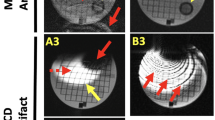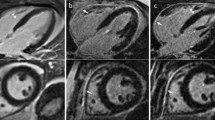Abstract
The border zone of post-infarction myocardial scar as identified by late gadolinium enhancement (LGE) has been identified as a substrate for arrhythmias and consequently, high-resolution 3D scar information is potentially useful for planning of electrophysiological interventions. This study evaluates the performance of a novel high-resolution 3D self-navigated free-breathing inversion recovery magnetic resonance pulse sequence (3D-SN-LGE) vs. conventional 2D breath-hold LGE (2D-LGE) with regard to sharpness of borders (SBorder) of post-infarction scar. Patients with post-infarction scar underwent two magnetic resonance examinations for conventional 2D-LGE and high-resolution 3D-SN-LGE acquisitions (both 15 min after 0.2 mmol/kg Gadobutrol IV) at 1.5T. In the prototype 3D-SN-LGE sequence, each ECG-triggered radial steady-state-free-precession read-out segment is preceded by a non-slice-selective inversion pulse. Scar volume and SBorder were assessed on 2D-LGE and matching reconstructed high-resolution 3D-SN-LGE short-axis slices. In 16 patients (four females, 58 ± 10y) all scars visualized by 2D-LGE could be identified on 3D-SN-LGE (time between 2D-LGE and 3D-SN-LGE 48 ± 53 days). A good agreement of scar volume by 3D-SN-LGE vs. 2D-LGE was found (Bland–Altman: −3.7 ± 3.4 ml, correlation: r = 0.987, p < 0.001) with a small difference in scar volume (20.5 (15.8, 35.2) ml vs. 24.5 (20.0, 41.9)) ml, respectively, p = 0.002] and a good intra- and interobserver variability (1.1 ± 4.1 and −1.1 ± 11.9 ml, respectively). SBorder of border “scar to non-infarcted myocardium” was superior on 3D-SN-LGE vs. 2D-LGE: 0.180 ± 0.044 vs. 0.083 ± 0.038, p < 0.001. Detection and quantification of myocardial scar by 3D-SN-LGE is feasible and accurate in comparison to 2D-LGE. The high spatial resolution of the 3D sequence improves delineation of scar borders.






Similar content being viewed by others
References
Kim RJ, Wu E, Rafael A, Chen EL, Parker MA, Simonetti O et al (2000) The use of contrast-enhanced magnetic resonance imaging to identify reversible myocardial dysfunction. N Engl J Med 343(20):1445–1453. doi:10.1056/NEJM200011163432003
Knuesel PR, Nanz D, Wyss C, Buechi M, Kaufmann PA, von Schulthess GK et al (2003) Characterization of dysfunctional myocardium by positron emission tomography and magnetic resonance: relation to functional outcome after revascularization. Circulation 108(9):1095–1100. doi:10.1161/01.CIR.0000085993.93936.BA
Gupta DK, Kwong RY, Pfeffer MA (2013) Cardiovascular imaging in clinical practice: what does late gadolinium enhance? Jama 309(9):929–930. doi:10.1001/jama.2013.1806
Kwong RY, Sattar H, Wu H, Vorobiof G, Gandla V, Steel K et al (2008) Incidence and prognostic implication of unrecognized myocardial scar characterized by cardiac magnetic resonance in diabetic patients without clinical evidence of myocardial infarction. Circulation 118(10):1011–1020. doi:10.1161/CIRCULATIONAHA.107.727826
Kelle S, Roes SD, Klein C, Kokocinski T, de Roos A, Fleck E et al (2009) Prognostic value of myocardial infarct size and contractile reserve using magnetic resonance imaging. J Am Coll Cardiol 54(19):1770–1777. doi:10.1016/j.jacc.2009.07.027
Gao P, Yee R, Gula L, Krahn AD, Skanes A, Leong-Sit P et al (2012) Prediction of arrhythmic events in ischemic and dilated cardiomyopathy patients referred for implantable cardiac defibrillator: evaluation of multiple scar quantification measures for late gadolinium enhancement magnetic resonance imaging. Circ Cardiovasc Imaging 5(4):448–456. doi:10.1161/CIRCIMAGING.111.971549.
Almehmadi F, Joncas SX, Nevis I, Zahrani M, Bokhari M, Stirrat J et al (2014) Prevalence of myocardial fibrosis patterns in patients with systolic dysfunction: prognostic significance for the prediction of sudden cardiac arrest or appropriate implantable cardiac defibrillator therapy. Circ Cardiovasc Imaging 7(4):593–600. doi:10.1161/CIRCIMAGING.113.001768.
Andreu D, Ortiz-Perez JT, Boussy T, Fernandez-Armenta J, de Caralt, Perea RJ et al (2014) Usefulness of contrast-enhanced cardiac magnetic resonance in identifying the ventricular arrhythmia substrate and the approach needed for ablation. Eur Heart J 35(20):1316–1326. doi:10.1093/eurheartj/eht510
Gupta S, Desjardins B, Baman T, Ilg K, Good E, Crawford T et al (2012) Delayed-enhanced MR scar imaging and intraprocedural registration into an electroanatomical mapping system in post-infarction patients. J Am Coll Cardiol Cardiovasc imaging 5(2):207–210. doi:10.1016/j.jcmg.2011.08.021
Sasano T, Abraham MR, Chang KC, Ashikaga H, Mills KJ, Holt DP et al (2008) Abnormal sympathetic innervation of viable myocardium and the substrate of ventricular tachycardia after myocardial infarction. J Am Coll Cardiol 51(23):2266–2275. doi:10.1016/j.jacc.2008.02.062
Rajchl M, Stirrat J, Goubran M, Yu J, Scholl D, Peters et al (2015) Comparison of semi-automated scar quantification techniques using high-resolution, 3-dimensional late-gadolinium-enhancement magnetic resonance imaging. Int J Cardiovasc Imaging 31:349–357. doi:10.1007/s10554-014-0553-2
Kino A, Keeling AN, Farrelly CT, Sheehan JJ, Davarpanah AH, Weele PJ et al (2011) Assessment of left ventricular myocardial scar in infiltrative and non-ischemic cardiac diseases by free breathing three dimensional phase sensitive inversion recovery (PSIR) TurboFLASH. Int J Cardiovasc Imaging 27(4):527–537. doi:10.1007/s10554-010-9640-1
Peters DC, Appelbaum EA, Nezafat R, Dokhan B, Han Y, Kissinger KV et al (2009) Left ventricular infarct size, peri-infarct zone, and papillary scar measurements: a comparison of high-resolution 3D and conventional 2D late gadolinium enhancement cardiac MR. J Magn Reson Imaging 30(4):794–800. doi:10.1002/jmri.21897
Pierce IT, Keegan J, Drivas P, Gatehouse PD, Firmin DN (2015) Free-breathing 3D late gadolinium enhancement imaging of the left ventricle using a stack of spirals at 3T. J Magn Reson Imaging 41(4):1030–1037. doi:10.1002/jmri.24643
Weingartner S, Akcakaya M, Roujol S, Basha T, Tschabrunn C, Berg S et al (2015) Free-breathing combined three-dimensional phase sensitive late gadolinium enhancement and T mapping for myocardial tissue characterization. Magn Reson Med 74:1032–1041. doi:10.1002/mrm.25495
Nehrke K, Bornert P, Manke D, Bock JC (2001) Free-breathing cardiac MR imaging: study of implications of respiratory motion–initial results. Radiology 220(3):810–815. doi:10.1148/radiol.2203010132
Spuentrup E, Manning WJ, Botnar RM, Kissinger KV, Stuber M (2002) Impact of navigator timing on free-breathing submillimeter 3D coronary magnetic resonance angiography. Magn Reson Med 47(1):196–201
Piccini D, Littmann A, Nielles-Vallespin S, Zenge MO (2012) Respiratory self-navigation for whole-heart bright-blood coronary MRI: methods for robust isolation and automatic segmentation of the blood pool. Magn Reson Med 68(2):571–579. doi:10.1002/mrm.23247
Piccini D, Monney P, Sierro C, Coppo S, Bonanno G, van Heeswijk RB et al (2014) Respiratory self-navigated postcontrast whole-heart coronary MR angiography: initial experience in patients. Radiology 270(2):378–386. doi:10.1148/radiol.13132045
Stehning C, Bornert P, Nehrke K, Eggers H, Stuber M (2005) Free-breathing whole-heart coronary MRA with 3D radial SSFP and self-navigated image reconstruction. Magn Reson Med 54(2):476–480. doi:10.1002/mrm.20557
Monney P, Piccini D, Rutz T, Vincenti G, Coppo S, Koestner SC et al (2015) Single centre experience of the application of self navigated 3D whole heart cardiovascular magnetic resonance for the assessment of cardiac anatomy in congenital heart disease. J Cardiovasc Magn Reson 17:55. doi:10.1186/s12968-015-0156-7
Ripa RS, Nilsson JC, Wang Y, Sondergaard L, Jorgensen E, Kastrup J (2007) Short- and long-term changes in myocardial function, morphology, edema, and infarct mass after ST-segment elevation myocardial infarction evaluated by serial magnetic resonance imaging. Am Heart J 154(5):929–936. doi:10.1016/j.ahj.2007.06.038
Manka R, Kozerke S, Rutz AK, Stoeck CT, Boesiger P, Schwitter J (2012) A CMR study of the effects of tissue edema and necrosis on left ventricular dyssynchrony in acute myocardial infarction: implications for cardiac resynchronization therapy. J Cardiovasc Magn Reson 14:47. doi:10.1186/1532-429X-14-47
Piccini D, Littmann A, Nielles-Vallespin S, Zenge MO (2011) Spiral phyllotaxis: the natural way to construct a 3D radial trajectory in MRI. Magn Reson Med 66(4):1049–1056. doi:10.1002/mrm.22898
Kording F, Schoennagel B, Lund G, Ueberle F, Jung C, Adam G et al (2014) Doppler ultrasound compared with electrocardiogram and pulse oximetry cardiac triggering: a pilot study. Magn Reson Med. doi:10.1002/mrm.25502
Bland JM, Altman DG (1986) Statistical methods for assessing agreement between two methods of clinical measurement. Lancet 1(8476):307–310
Ziv O, Schofield L, Lau E, Chaves L, Patel D, Jeng P et al (2012) A novel, minimally invasive, segmental myocardial infarction with a clear healed infarct borderzone in rabbits. Am J Physiol Heart Circ Physiol 302(11):H2321–H2330. doi:10.1152/ajpheart.00031.2012
Pop M, Ramanan V, Yang F, Zhang L, Newbigging S, Ghugre NR et al (2014) High-resolution 3-D T1*-mapping and quantitative image analysis of GRAY ZONE in chronic fibrosis. IEEE Trans Biomed Eng 61(12):2930–2938. doi:10.1109/TBME.2014.2336593
Estner HL, Zviman MM, Herzka D, Miller F, Castro V, Nazarian S et al (2011) The critical isthmus sites of ischemic ventricular tachycardia are in zones of tissue heterogeneity, visualized by magnetic resonance imaging. Heart Rhythm 8(12):1942–1949. doi:10.1016/j.hrthm.2011.07.027
Bhagirath P, van der Graaf M, Karim R, Rhode K, Piorkowski C, Razavi R et al (2015) Interventional cardiac magnetic resonance imaging in electrophysiology: advances toward clinical translation. Circ Arrhythm Electrophysiol 8(1):203–211. doi:10.1161/CIRCEP.114.002371
Babu-Narayan SV, Kilner PJ, Li W, Moon JC, Goktekin O, Davlouros PA et al (2006) Ventricular fibrosis suggested by cardiovascular magnetic resonance in adults with repaired tetralogy of fallot and its relationship to adverse markers of clinical outcome. Circulation 113(3):405–413. doi:10.1161/CIRCULATIONAHA.105.548727
Pfeffer MA, Braunwald E (1990) Ventricular remodeling after myocardial infarction. Experimental observations and clinical implications. Circulation 81(4):1161–1172
Mather AN, Fairbairn TA, Artis NJ, Greenwood JP, Plein S (2011) Timing of cardiovascular MR imaging after acute myocardial infarction: effect on estimates of infarct characteristics and prediction of late ventricular remodeling. Radiology 261(1):116–126. doi:10.1148/radiol.11110228
Oshinski JN, Yang Z, Jones JR, Mata JF, French BA (2001) Imaging time after Gd-DTPA injection is critical in using delayed enhancement to determine infarct size accurately with magnetic resonance imaging. Circulation 104(23):2838–2842
Nguyen TD, Spincemaille P, Weinsaft JW, Ho BY, Cham MD, Prince MR et al (2008) A fast navigator-gated 3D sequence for delayed enhancement MRI of the myocardium: comparison with breathhold 2D imaging. J Magn Reson Imaging 27(4):802–808. doi:10.1002/jmri.21296
Dietrich O, Raya JG, Reeder SB, Reiser MF, Schoenberg SO (2007) Measurement of signal-to-noise ratios in MR images: influence of multichannel coils, parallel imaging, and reconstruction filters. J Magn Reson Imaging 26(2):375–385. doi:10.1002/jmri.20969
Kellman P, Arai AE, McVeigh ER, Aletras AH (2002) Phase-sensitive inversion recovery for detecting myocardial infarction using gadolinium-delayed hyperenhancement. Magn Reson Med 47(2):372–383
Kido T, Kido T, Nakamura M, Kawaguchi N, Nishiyama Y, Ogimoto A et al (2014) Three-dimensional phase-sensitive inversion recovery sequencing in the evaluation of left ventricular myocardial scars in ischemic and non-ischemic cardiomyopathy: comparison to three-dimensional inversion recovery sequencing. Eur J Radiol. doi:10.1016/j.ejrad.2014.09.014
Ambale-Venkatesh B, Lima JA (2014) Cardiac MRI: a central prognostic tool in myocardial fibrosis. Nat Rev Cardiol. doi:10.1038/nrcardio.2014.159
Kwong RY, Farzaneh-Far A (2011) Measuring myocardial scar by CMR. J Am Coll Cardiol Cardiovasc Imaging 4(2):157–160. doi:10.1016/j.jcmg.2010.12.004
Grant support
This work is in part supported by the Swiss National Science Foundation (SNF) Grant 320030_143923.
Author information
Authors and Affiliations
Corresponding author
Ethics declarations
Conflict of interest
DP is an employee of Siemens Healthcare Switzerland. JS receives research grant support by Bayer Healthcare, Bracco and Siemens Healthcare, Switzerland. TR, JC, SC, GG, GV and MS declare no competing interests.
Rights and permissions
About this article
Cite this article
Rutz, T., Piccini, D., Coppo, S. et al. Improved border sharpness of post-infarct scar by a novel self-navigated free-breathing high-resolution 3D whole-heart inversion recovery magnetic resonance approach. Int J Cardiovasc Imaging 32, 1735–1744 (2016). https://doi.org/10.1007/s10554-016-0963-4
Received:
Accepted:
Published:
Issue Date:
DOI: https://doi.org/10.1007/s10554-016-0963-4




